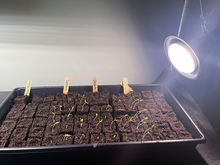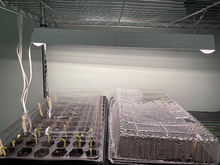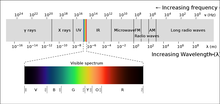If you’ve shopped for grow lights recently, you have likely noticed that there are a lot of different options for seed-starting lights. They come in a variety of colors, shapes and prices. Let's break down which options may best suit your seed-starting needs.
Shapes and sizes
Grow lights are sold in a variety of shapes and sizes, from bulbs that look like those you would put in a lamp, to clip-on rods, to long shop lights. The best size and shape for you depends on the orientation of your seed starting setup.
Ideally, your light should be positioned directly above your seedlings. If it’s off to the side or too high above them, they will stretch to reach it, resulting in thin, weak stems.
So, if you only have one tray of seedlings, a single bulb model will likely work fine, especially if you have some natural lighting to supplement it like a bright window. A better, usually more expensive option, would be a tube light that is the length of your seedling tray so that the light is more evenly distributed.
If you’re starting multiple seedling flats, a longer shop light will allow fairly uniform coverage across your trays.
Bulb technology
Most gardeners use either fluorescent lights or light-emitting diode (LED) bulbs. There are other types of grow lights like sodium vapor lights, but they are harder to find and more commonly used in commercial greenhouse settings.
For many years, fluorescent shop lights were the go-to seed starting bulbs for gardeners, but LEDs have quickly replaced them as the standard choice. LEDs are usually more expensive than fluorescent bulbs, but they are very energy-efficient and long-lasting. They also do not produce excess heat and have become available in a wide variety of shapes and sizes. Both types are typically available at local hardware stores, online and at garden centers.
Light color
Plants use light in the photosynthetically active radiation spectrum, which includes wavelengths ranging from 400 (violet) to 700 (red) nanometers. Typically, plants use more blue and blue-green light when they are seedlings, and more red light later on in their life cycles when they begin to flower and produce seeds.
If you are just using grow lights to start seeds or to grow leafy vegetables, stick to lights that are labeled either as blue-green spectrum or balanced light spectrum. It is increasingly common for lights to be labeled “for greens and seeds” or “for flowers and fruit”.
Light intensity
In general, when buying grow lights, more light intensity is better. Lights typically have a Watt measurement, which is the amount of energy needed to power the light. They should also have a unit of light intensity, reported as PPF (photosynthetic photon flux) or foot-candles (the amount of light received by a 1 sq. ft surface located 1 foot away from a light source is equal to one candle). The PPF of common grow lights ranges from around 10-50, and higher is generally better for seedlings.
Having a high PPF rating (or foot candle rating) is especially important in a few scenarios:
- For seedlings that need to be planted very early, like peppers or tomatoes, more light is especially important. A seedling that is planted indoors just a couple of weeks before being transplanted outdoors can catch up outside, but a seedling that spends months indoors needs all of the light it can get to produce strong stems and to get a good head start on the growing season.
- For seedlings planted in a very bright window, a less intense supplemental grow light might be fine. But if you’re starting seeds in an area with little natural light, a higher intensity grow light will be a better fit.
For more information about indoor plant lighting, check out our Lighting for Indoor Plants page.





